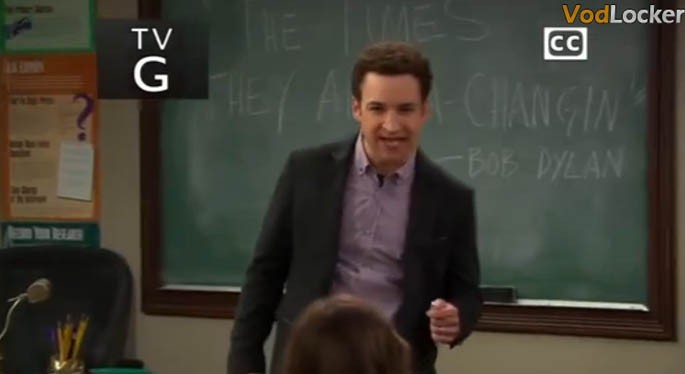“Girl Meets World,” the sequel series to the beloved “Boy Meets World,” often blends heartwarming life lessons with comedic scenarios. In the episode “Girl Meets 1961,” the show attempts to transport its young characters, and viewers, back to the vibrant and transformative decade of the 1960s. While aiming to teach the importance of history, the episode embarks on a journey that’s both vaguely heartwarming and, at times, bewilderingly silly.
The episode kicks off in Mr. Cory Matthews’ history class, where the students are, to put it mildly, unenthusiastic about learning about the 1960s. Their boredom is palpable, and Maya Hart, ever the contrarian, voices the sentiment that history is irrelevant to their present lives. This sets the stage for Cory’s passionate, if slightly theatrical, outburst about the importance of understanding the past to shape the future. In a moment of inspired (or perhaps desperate) teaching, Cory proposes a unique assignment: a class trip back to the 1960s, not literally through time travel, but through exploring their family histories and the lives of their grandparents and great-grandparents during that era.
Riley Matthews, Cory’s daughter, questions the feasibility of going back to a time before they were born. Cory cleverly reframes the concept, emphasizing that they were there, in a sense, through their ancestors. The assignment becomes a quest to uncover what life was like for their relatives in the 60s. While the initial setup feels a bit contrived – it’s hard to believe students would be universally bored by the 60s, a decade rich with cultural and political upheaval – the assignment itself holds a spark of genuine creativity. It’s an engaging way to make history personal and relatable for young learners.
The scene then abruptly shifts to Greenwich Village, 1961. Riley and Farkle, in full beatnik attire, materialize in what appears to be a coffee shop, evoking the bohemian spirit of the time. The portrayal, however, leans heavily into caricature. Riley, now “Rosie McGee,” and Farkle, self-styled “Ginsberg,” engage in exaggerated beatnik dialogue, complete with finger-snapping and pseudo-intellectual pronouncements. While the costumes and setting attempt to capture the aesthetic of the Beat Generation, the dialogue often feels forced and anachronistic, missing the nuance and complexity of the era’s counterculture.
The coffee shop scene introduces other characters who become central to the episode’s narrative. Rosie encounters “May,” a blonde girl with dreams of reaching Topanga Canyon, a haven for artists and free spirits. May is portrayed by Maya in a blonde wig, a detail that hints at a deeper connection yet to be revealed. This encounter sets in motion a series of revelations about the students’ family histories, linking them to this specific moment in 1961 Greenwich Village.
Back in the present day, the assignment unfolds as the students present their findings. Lucas Friar discovers that his great-grandfather, Merlin Scoggins, was a musician who had a hit record in the 60s. This revelation, while seemingly disconnected from the broader social and political context of the decade, becomes Lucas’s point of connection to the past. The episode glosses over the significant civil rights movement, the escalating Vietnam War, and the burgeoning counterculture that defined the 1960s, choosing instead to focus on personal stories and coincidental connections.
Riley’s presentation centers on her great-grandmother, Rosie, portrayed in the flashback as a wide-eyed optimist. The focus is less on the historical context of the 60s and more on Rosie’s personality and values. This approach, while heartwarming, misses an opportunity to explore the complexities and challenges of the era through a personal lens. Learning about the 60s through family history could have been a powerful tool to understand the social changes and historical events that shaped the world we live in today.
The episode does manage to weave in some touching moments. Riley’s discovery that Rosie is her maternal great-grandmother, connecting her to Topanga’s lineage, adds an unexpected layer to the family dynamics. The gift of Rosie’s guitar to Maya, encouraging her artistic pursuits, provides a heartwarming resolution to Maya’s earlier artistic insecurities. These moments of connection and encouragement are typical of “Girl Meets World” and resonate with the show’s core themes of friendship and family.
Farkle’s presentation brings the various storylines together. He reveals that his great-grandfather, Ginsberg, was also present at the same Greenwich Village cafe in 1961, taking photos of Rosie and May. This contrived coincidence strains credulity, suggesting a smallness to history that undermines the vastness and complexity of the 1960s. The revelation that May, the aspiring artist from the cafe, is Maya’s great-grandmother, further tightens these interwoven family histories.
The episode concludes with the friends realizing the interconnectedness of their families and, by extension, the interconnectedness of history. Cory Matthews then segues into a recitation of Martin Luther King Jr.’s “I Have a Dream” speech, a powerful and relevant historical reference, albeit somewhat abruptly tacked onto the episode’s narrative. While the intention to connect the personal family stories to the broader historical context is admirable, the execution feels somewhat forced.
“Girl Meets 1961” is a mixed bag when it comes to “Girl Meets World Learning About The 60s.” While it attempts to make history engaging through a personal family history project, it often relies on caricature and contrived coincidences. The episode prioritizes heartwarming family connections over a deeper exploration of the significant social and political issues of the 1960s. While it succeeds in delivering the feel-good moments characteristic of “Girl Meets World,” it ultimately falls short of providing a meaningful or nuanced lesson about this transformative decade. The potential to truly learn about the 60s is present, but the execution prioritizes sentimentality over substantial historical engagement.
